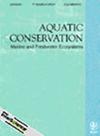预测海洋软骨鱼类(Chondrichthyes,Huxley,1880 年)全球灭绝风险的生物生态属性
IF 2.2
3区 环境科学与生态学
Q3 ENVIRONMENTAL SCIENCES
引用次数: 0
摘要
海洋软骨鱼类正在经历全球性的衰退,但由于缺乏基本的生物信息(如生长参数和繁殖),确定适当的保护行动具有挑战性。在这项研究中,我们确定了既容易获得又能有效预测灭绝威胁的生物和生态属性。 我们为海洋软骨鱼类物种构建了一个生物生态属性数据库,其中包括最大长度、栖息地、繁殖模式、营养级和保护状况等信息。数据来源包括 Shark-References、IUCN 和 FishBase 数据库。随后,建立了一个以保护状况为响应变量、生物生态属性为解释变量的广义线性模型,并对各组模型的准确性进行了测试。然后,将该模型应用于尚未分类的物种(数据不足 [DD] 或未评估 [NE]),以确定其灭绝风险概率。 总共收集到了 1225 种海洋软骨鱼类(537 种鲨鱼、636 种鳐鱼和 52 种奇美拉鱼)的数据;其中约 20% 的物种被归类为 DD 或 NE。该模型的总体准确率很高:奇美拉鱼的准确率为 95%,鳐鱼的准确率为 77%,鲨鱼的准确率为 72%。我们的分析表明,在被归类为 DD 或 NE 的物种中,58% 的鳐鱼、44% 的鲨鱼和 66% 的奇马可能面临灭绝风险。 这些结果清楚地表明,生物生态属性可以作为软骨鱼类灭绝风险的替代物,并为这一具有重要生态意义但数据贫乏的类群的保护规划和优先次序的确定奠定了坚实的基础。本文章由计算机程序翻译,如有差异,请以英文原文为准。
Bioecological Attributes as Predictors of Global Extinction Risk for Marine Chondrichthyans (Chondrichthyes, Huxley, 1880)
- Marine chondrichthyans are experiencing a global decline, but identifying appropriate conservation actions is challenging due to the lack of basic biological information, such as growth parameters and reproduction. In this study, we identify biological and ecological attributes that can be both easily obtainable and are effective predictors of extinction threat.
- A bioecological attribute database was constructed for marine chondrichthyan species, including information on maximum length, habitat, reproductive mode, trophic level and conservation status, among others. Data sources included the Shark-References, IUCN and FishBase databases. Following this, a generalized linear model was built with conservation status as the response variable and bioecological attributes as explanatory variables, and the model's accuracy was tested for each group. Then, the model was applied to species not yet classified (data deficient [DD] or not evaluated [NE]) to determine their probability of extinction risk.
- In total, data were compiled for 1225 species of marine Chondrichthyes (537 sharks, 636 rays and 52 chimaeras); approximately 20% of these species are classified as DD or NE. The model demonstrated high accuracy overall: 95% for chimaeras, 77% for rays and 72% for sharks. Our analysis indicates that, among the species that are classified as DD or NE, 58% of rays, 44% of sharks and 66% of chimaeras may be at risk of extinction.
- These results clearly demonstrate how bioecological attributes can serve as proxies of extinction risk in Chondrichthyes and provide a solid foundation for conservation planning and prioritization for this ecologically important yet data poor taxon.
求助全文
通过发布文献求助,成功后即可免费获取论文全文。
去求助
来源期刊

Aquatic Conservation-Marine and Freshwater Ecosystems
环境科学-海洋与淡水生物学
CiteScore
5.50
自引率
4.20%
发文量
143
审稿时长
18-36 weeks
期刊介绍:
Aquatic Conservation: Marine and Freshwater Ecosystems is an international journal dedicated to publishing original papers that relate specifically to freshwater, brackish or marine habitats and encouraging work that spans these ecosystems. This journal provides a forum in which all aspects of the conservation of aquatic biological resources can be presented and discussed, enabling greater cooperation and efficiency in solving problems in aquatic resource conservation.
 求助内容:
求助内容: 应助结果提醒方式:
应助结果提醒方式:


